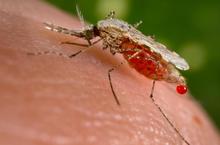According to a report on research in Texas related to mosquitoes and West Nile virus, a vector-rating index system may help identify the best time for taking steps to prevent outbreaks of West Nile virus disease.

Mosquito bite - Source of West Nile virus
Milder winters and unusually warm spring temperatures contribute to epidemic years for West Nile, a major concern as global temperatures continue to warm.
© 2013 by US Gov - CDC
Although the research was directed toward humans, implications that the system would also work to prevent outbreaks in equines are evident.
Using data from the 2012 outbreak that occurred in Dallas County, Texas, along with analysis of a decade of West Nile infections, weather and housing date, University of Texas Southwestern Medical Center researchers determined that the best way to avoid an outbreak was to determine a mosquito vector index.
The vector index value is calculated from the abundance of mosquitoes and the percentage of mosquitoes infected with West Nile virus.
According to Dr. Robert Haley, chief of epidemiology and professor of internal medicine at UT Southwestern and senior author of the study published in the July 17 edition of the Journal of the American Medical Association "When the vector index goes above 0.5 early -- in June or July -- large numbers of people are silently infected, and this is the best time to intervene," said Dr. Robert Haley.
"In years when the vector index did not rise until late July or August, impending outbreaks just sputtered -- in late summer mosquito abundance declines, and mosquitoes become less active and stop biting as much."
The analysis also found that milder winters and unusually warm spring temperatures contributed to epidemic years for West Nile, a major concern as global temperatures continue to warm.
Another finding in the research showed that house mosquitoes are more apt to be carriers of the virus than forest mosquitoes.
According to the researchers, the analysis tools used in the study may be applicable elsewhere, but due to variations in weather, mosquito populations, and other factors, each region or county will need to conduct its analysis to identify the most appropriate vector-index rating signaling when to act.
"Given the leading character of this index, epidemiologists and government officials can implement, in a more timely manner, preventative measures to reduce the impact of future West Nile Virus outbreaks," said Dr. Tom Fomby, professor of economics in the Dedman College of Humanities and Sciences at Southern Methodist University, who contributed statistical methods more commonly used in economics to evaluate the vector index.
It stands to reason that veterinarians and horse owners working with epidemiologists and government officials can also make use of the vector-index rating information to determine when cases of equine West Nile disease are most apt to occur.
This awareness can lead to better vaccine protocols and also to an emphasis on areas where the disease is most likely to affect the horse population.
Learn more about West Nile Virus in horses.
